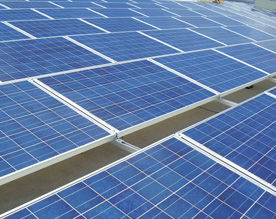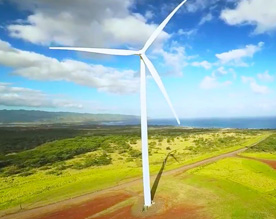
Renewable Resources
Diversifying Hawaii's fuel mix by using more locally produced renewable energy
Renewable Energy Sources
What is renewable energy?
Electricity can be generated from a variety of resources. Some are fossil fuels such as oil and coal. Over 80 percent of all the energy used in Hawaii for electricity, surface and air transportation comes from imported fossil fuels, mostly oil and some coal. Fossil fuels were formed underground over millions of years as organic material like plants and animals were compressed. Once fossil fuels are used they cannot be replaced. We call an energy source "renewable" or "sustainable" if it can be replenished -- such as biomass, biofuels or garbage -- or will never run out -- such as the sun, wind or ocean movement.
Sources of Renewable Energy
Follow these links to learn more about the status and future plans for the different types of renewable energy available in Hawaii.
Why is it Important?
Renewable energy can:
- Reduce Hawaii's consumption of oil. Oil must be imported to Hawaii, often from unstable, turbulent places over thousands of miles of open ocean. Oil prices are lower today but Hawaii is vulnerable economically to increases in the price of oil and disruptions in supply. To increase our energy security and keep more of our energy dollars at home, we need to use local, renewable resources at more stable prices.
- Protect Hawaii's environment and reduce our impact on global warming. Burning fossil fuels creates carbon dioxide and other emissions that cause global climate change. As islands in the middle of the Pacific, Hawaii is vulnerable to rising sea levels, longer and more violent storms, and longer, drier droughts. Although Hawaii's carbon footprint and our contribution to global climate change are small, it's important that we all do our part.
Reducing Imported Oil
Hawaii has historically depended on imported oil for most of its energy needs for many reasons. Unlike mainland states, Hawaii does not have access to fuel sources such large rivers to produce hydropower. The islands do not have indigenous oil, natural gas or coal resources. Such fuels need to be imported. Petroleum is relatively easy to transport and store; it can be easily refined to create fuel for a full spectrum of air, water and ground transportation, electricity and other uses.
Diversifying Hawaii's mix of energy sources by using more locally produced renewable energy at lower and more stable pricing to produce electricity (and for transportation when possible) is the best way to help Hawaii use less oil.
Only about one third of Hawaii's imported oil is used to make electricity. About one third goes for jet fuel and about one third goes for gasoline and diesel for ground and water transportation. Although using renewable energy will reduce Hawaii's use of oil to produce electricity, it won't eliminate the need to import crude oil or refined product to Hawaii as long as fuel is needed for ground and air transportation. This is one reason Hawaiian Electric advocates electric vehicles.











